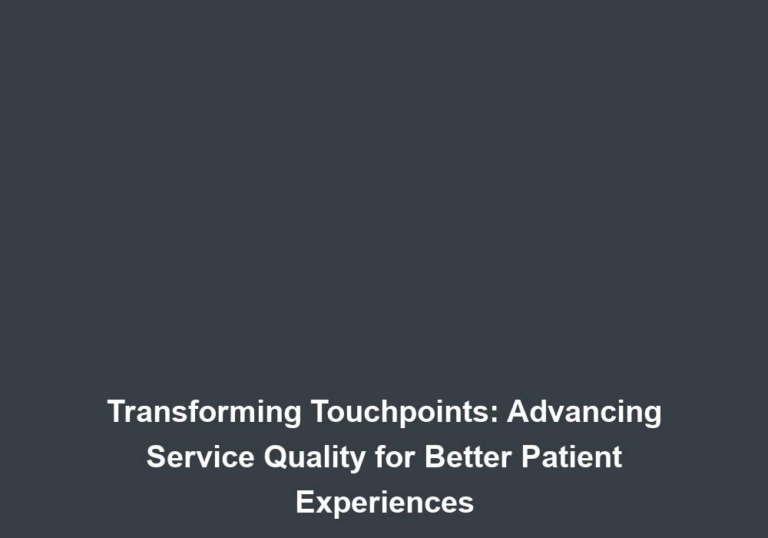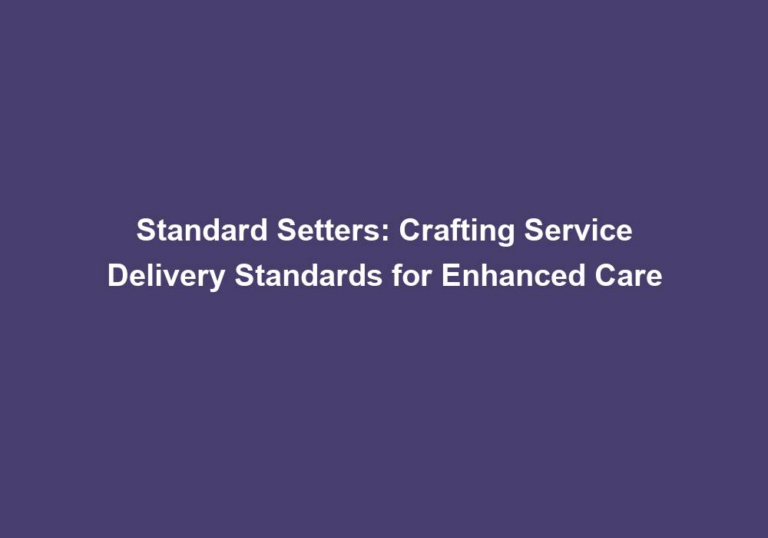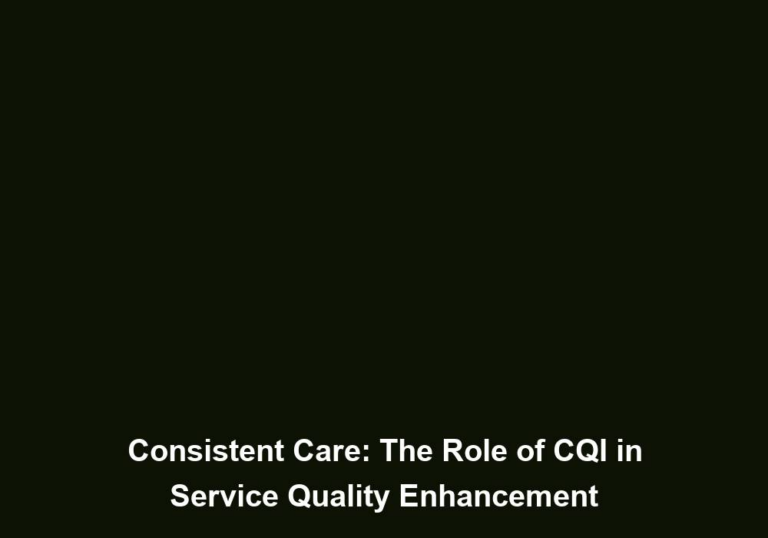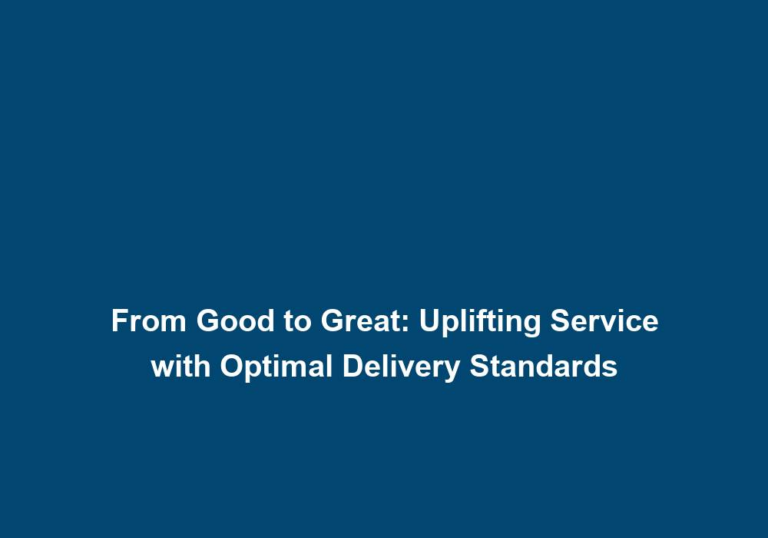Benchmarking Betterment: Setting Service Delivery Standards in Healthcare
In the rapidly evolving world of healthcare, it is crucial for organizations to consistently improve their service delivery standards. By benchmarking against industry-leading practices, healthcare providers can identify areas for improvement, enhance patient satisfaction, and ultimately achieve better outcomes. This article aims to explore the concept of benchmarking in healthcare and highlight its significance in setting service delivery standards.
Understanding Benchmarking in Healthcare
Benchmarking is a systematic process that involves comparing an organization’s practices, processes, and outcomes against those of its peers or industry leaders. In the context of healthcare, benchmarking enables organizations to assess how they are performing in comparison to others and identify opportunities for improvement. By evaluating key performance indicators (KPIs) and best practices, healthcare providers can aim to surpass industry standards and deliver exceptional care.
Benchmarking in healthcare can be classified into several types, each serving a distinct purpose. These types include:
Internal Benchmarking
Internal benchmarking involves comparing performance between different departments or units within the same organization. This type of benchmarking allows healthcare providers to identify variations in performance and share best practices within their own healthcare system. By fostering collaboration and encouraging continuous improvement across the organization, internal benchmarking can significantly enhance service delivery.
Some key benefits of internal benchmarking include:
- Sharing of best practices within the organization
- Identifying areas of improvement within different departments or units
- Encouraging collaboration and learning from each other
Competitive Benchmarking
Competitive benchmarking involves comparing performance against direct competitors or organizations with similar service offerings. By analyzing the practices of industry leaders, healthcare providers can identify strategies that differentiate their services and gain a competitive edge. This type of benchmarking helps organizations understand market trends and make informed decisions to improve their market position.
Some key benefits of competitive benchmarking include:
- Identifying strategies to differentiate services from competitors
- Understanding market trends and customer expectations
- Gaining insights into successful practices that can be adopted
Functional Benchmarking
Functional benchmarking involves comparing processes and practices between organizations that may not be direct competitors but share similar functions or challenges. For example, a healthcare provider can benchmark its appointment scheduling process against a leading airline’s ticket booking system to identify opportunities for improvement. Functional benchmarking allows organizations to learn from diverse industries and apply innovative practices to their own operations.
Some key benefits of functional benchmarking include:
- Learning from industries that have similar challenges or processes
- Identifying innovative practices from unrelated sectors
- Applying successful strategies to improve own operations
Collaborative Benchmarking
Collaborative benchmarking involves partnerships between multiple healthcare organizations to jointly identify and address shared challenges. This type of benchmarking fosters collaboration and knowledge-sharing among organizations, leading to collective improvement across the healthcare sector. Collaborative benchmarking initiatives can focus on specific areas, such as reducing readmission rates or improving patient safety.
Some key benefits of collaborative benchmarking include:
- Sharing knowledge and best practices among multiple organizations
- Addressing shared challenges collectively
- Driving sector-wide improvement through collaboration
Key Steps in the Benchmarking Process
To successfully benchmark and set service delivery standards, healthcare providers should follow a structured approach. Here are the key steps involved:
-
Identify the Focus Areas: Determine the specific areas or processes that require improvement. This could include patient wait times, appointment scheduling, medication management, or any other aspect of service delivery.
-
Select Relevant Benchmarks: Identify benchmarking partners or industry leaders who excel in the chosen focus areas. This can be done through literature review, conferences, professional networks, or collaboration platforms.
-
Gather Data: Collect relevant data and information about the chosen benchmarking partners. This can include performance metrics, process documentation, patient satisfaction surveys, and other relevant data sources.
-
Compare and Analyze: Compare the collected data against the organization’s own performance metrics. Analyze the differences and identify areas of improvement or potential best practices to adopt.
-
Develop an Action Plan: Based on the analysis, develop an action plan outlining specific steps to improve service delivery. This may include process redesign, staff training, technology adoption, or any other necessary interventions.
-
Implement and Monitor: Put the action plan into practice and closely monitor the impact of the improvements made. Continuously track performance metrics and gather feedback from patients and staff to ensure sustained progress.
-
Review and Reassess: Regularly review the benchmarking process and reassess the identified focus areas to ensure ongoing improvement. Benchmarking should be an iterative process that supports continuous learning and adaptation.
Conclusion
Benchmarking plays a pivotal role in setting service delivery standards in healthcare. By comparing practices, processes, and outcomes against industry leaders, healthcare providers can identify areas for improvement, enhance patient satisfaction, optimize efficiency, and drive innovation. Through internal, competitive, functional, and collaborative benchmarking, organizations can continuously learn from others, adopt best practices, and deliver exceptional care in an ever-evolving healthcare landscape.






